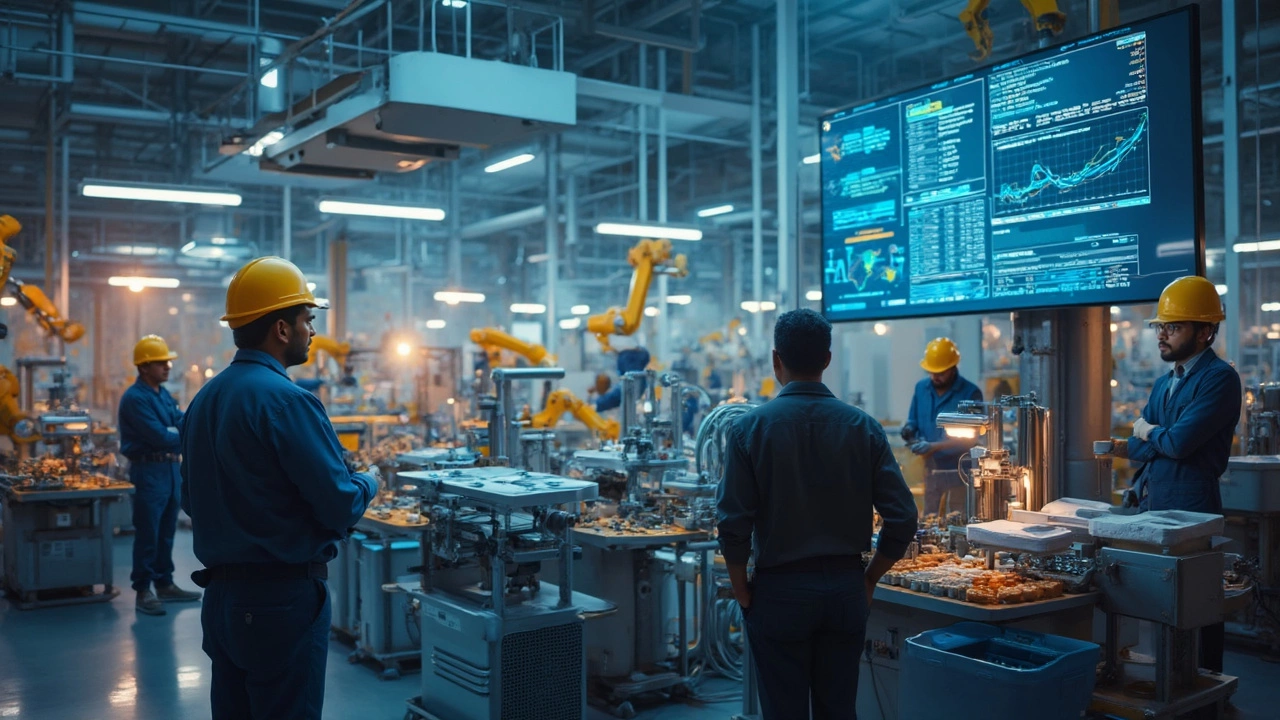Is U.S. Manufacturing Growing? The Real Story Behind Government Schemes

For years, we’ve heard politicians promise a new golden age for American manufacturing. But is it finally happening, or just more talk? If you dig into the latest numbers, you’ll notice U.S. factory construction hit its highest level in decades, especially since 2023. Major companies are actually building new plants—for semiconductors, electric vehicles, batteries—thanks in part to huge government incentives.
The Inflation Reduction Act and the CHIPS Act are the big players here, dropping billions into the industry. These aren’t just flashy press releases; they’re shaping real projects. For example, TSMC and Intel are both building giant chip factories in Arizona and Ohio. This means high-tech jobs, not just the usual steel and auto gigs we remember from history books.
- Where Are the Numbers Pointing?
- Government Schemes That Actually Matter
- On the Factory Floor: Real-World Impact
- How to Track U.S. Manufacturing Growth Yourself
Where Are the Numbers Pointing?
If you want to know whether U.S. manufacturing is honestly growing, let’s talk about hard numbers—not just slogans. Data from the Federal Reserve says production in American factories climbed around 2.1% throughout 2023. Nothing wild, but the small jumps add up, especially considering the messy supply chain issues during and after the pandemic. It’s even more interesting when you peek at factory construction spending—it more than doubled between 2022 and 2024, hitting over $200 billion for the first time ever. A lot of this comes from new high-tech sectors, not only the old-school ones like steel and textiles.
Check out how some of the big numbers stack up in recent years:
| Year | U.S. Manufacturing Output Growth (%) | New Factory Construction ($ Billion) | No. of Jobs Added |
|---|---|---|---|
| 2021 | 3.9 | 79 | 350,000 |
| 2022 | 2.3 | 108 | 390,000 |
| 2023 | 2.1 | 168 | 200,000 |
| 2024 | 1.8 (prelim.) | 212 | 185,000 |
Not all sectors are winners, though. Electronics, electric vehicles, and batteries are surging, but some traditional fields, like furniture and printing, are shrinking or barely hanging on. For many workers, the new jobs require technical skills rather than just physical labor. That means more training programs—and more chances for anyone ready to learn.
If you're wondering whether these gains are all because of government schemes, the truth is a mixed bag. Sure, those headline-grabbing laws helped jump-start projects that might have stayed on the drawing board. Still, global demand, reshoring trends, and new tech are big pieces of the puzzle too.
Government Schemes That Actually Matter
The last few years saw the government roll out some truly massive bills to breathe life back into U.S. manufacturing. These aren’t just headlines—they come with cash, tax breaks, and specific goals. Here’s what’s actually moving the needle.
The CHIPS and Science Act, passed in late 2022, is pumping over $52 billion straight into semiconductor manufacturing and research. Why? America was tired of relying on foreign-made chips, especially after supply chain meltdowns in 2021. By May 2025, at least ten states are getting new chip plants, with Arizona, Ohio, and Texas leading the way. Intel alone is investing $20 billion in its Ohio project, and TSMC is dropping $40 billion in Arizona—record numbers for factory builds.
Then there's the Inflation Reduction Act (IRA) from 2022. This one’s all about clean energy and includes incentives to make batteries, solar panels, and electric vehicles in the U.S. Hundreds of companies scrambled to build new facilities or expand old ones, hungry for the production tax credits. There’s a boom in EV battery gigafactories, with states like Michigan and Georgia grabbing headlines.
Some real results? Check out this table showing public funds driving new private investment since these schemes kicked off:
| Act | Public Investment | Private Investment Triggered | Major Company Announcements |
|---|---|---|---|
| CHIPS Act | $52B | $200B+ | Intel, TSMC, Micron |
| Inflation Reduction Act | $370B* | $240B+ (2023-2024) | Ford, LG Energy, Tesla |
*IRA includes broad climate programs; figures above focus on manufacturing incentives.
- Job creation is up: about 200,000 new manufacturing jobs since early 2023, with growth mostly in clean energy and electronics.
- The government tracks results—any builder taking federal funds has to report on job numbers, pay, and local impact, which means watchdogs and everyday folks can keep tabs.
The takeaway? These aren’t normal stimulus checks or short-term grants. They’re tying public money directly to factory construction, jobs, and supply chains. Not every project is smooth, but the programs are doing what they’re designed for—making stuff here again, not overseas.

On the Factory Floor: Real-World Impact
Walk into a new battery plant in Georgia or a chip fab in Arizona and you’ll notice something: the mix of jobs isn’t what it used to be. Sure, there’s still a need for folks who know their way around heavy machinery, but there are also jobs for software techs, engineers, and even cleanroom specialists. This isn’t grandpa’s assembly line anymore. Modern American factories are hiring faster, paying more, and demanding new skills.
Why the change? It’s mostly because of billions invested by companies nudged along by federal schemes—the U.S. manufacturing sector is seeing its biggest revival since the 1980s. Intel’s $20 billion chip plant in Ohio, Hyundai’s $5.5 billion electric vehicle hub near Savannah, and Ford’s BlueOval battery project in Tennessee are just a few headline examples.
Let’s look at some numbers that show what’s been happening on the ground:
| Project | Location | Jobs Created | Investment (USD) | Opening Year |
|---|---|---|---|---|
| Intel Chip Plant | New Albany, OH | 3,000+ (plus 7,000 in construction) | $20 billion | 2025 (expected) |
| Hyundai EV Plant | Bryan County, GA | 8,100 (plus 2,000 construction) | $5.5 billion | 2025 |
| TSMC Semiconductor Fab | Phoenix, AZ | 4,500 (up to 21,000 construction) | $40 billion | 2025 (expected) |
| Ford BlueOval Battery Park | Stanton, TN | 6,000 (plus thousands in construction) | $5.6 billion | 2025 |
You’re probably wondering—are these jobs just for engineers? Nope. Roughly 60% of new manufacturing roles linked to these big projects are in production, maintenance, quality assurance, or logistics. So if you’re thinking of switching careers or picking up new skills, there’s opportunity beyond just a four-year college degree.
But it’s not all sunshine. Manufacturers still struggle to fill these spots. The National Association of Manufacturers said there were about 620,000 open manufacturing jobs as of March 2025. The skills gap is real. Companies are teaming up with nearby community colleges and trade schools, sometimes offering paid training or tuition help to get new hires up to speed.
If you’re aiming to get into this new wave of factory work, here are a few steps that could help:
- Check for local public-private apprenticeships, especially near new plants.
- Look at short certifications in logistics, robotics, or industrial safety—they boost your chances.
- Don’t overlook non-degree programs at technical colleges. Many have direct pipelines to employers.
How to Track U.S. Manufacturing Growth Yourself
If you don’t want to rely on headlines or politicians, it’s totally possible to look at real data about U.S. manufacturing growth yourself. This stuff isn’t hidden behind paywalls or buried in old textbooks—you just need to know where to look and how to make sense of it.
Start with the Federal Reserve’s monthly Industrial Production report. It tracks how much stuff America’s factories are actually making. The 'Manufacturing Output' part is the key number. If it’s climbing, factories are busy. Here’s what the recent data shows:
| Month/Year | Manufacturing Output (Year-over-Year % Change) |
|---|---|
| April 2023 | +1.1% |
| October 2023 | +2.2% |
| April 2024 | +3.0% |
For jobs, check out the Bureau of Labor Statistics (BLS). Their ‘Current Employment Statistics’ page breaks down jobs by sector—so you can see how many folks are working in factories. You can also look at the 'Job Openings and Labor Turnover Survey' (JOLTS) from the BLS to see if companies are struggling to fill factory roles.
If you only care about the big new factories, check construction spending reports from the U.S. Census Bureau—look for ‘Manufacturing Construction’. Spending on this has doubled since 2021, which shows companies are putting real money on the line.
Here’s a quick list of links and tips that’ll save time:
- Federal Reserve Industrial Production: Just Google “Federal Reserve G.17 Report.”
- BLS Manufacturing Employment: Hit up the BLS website and search ‘Manufacturing’ under Current Employment Statistics.
- Census Manufacturing Construction: Go to the Census ‘Construction Spending’ monthly data and filter by manufacturing.
One quick tip: Don’t let a single bad (or good) month fool you. Look at 6-12 months of data to spot real trends, not just blips. Bookmark the main pages above if you want to check progress anytime.